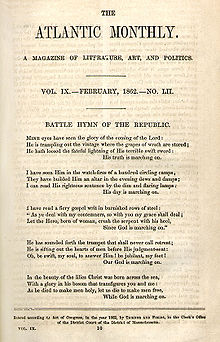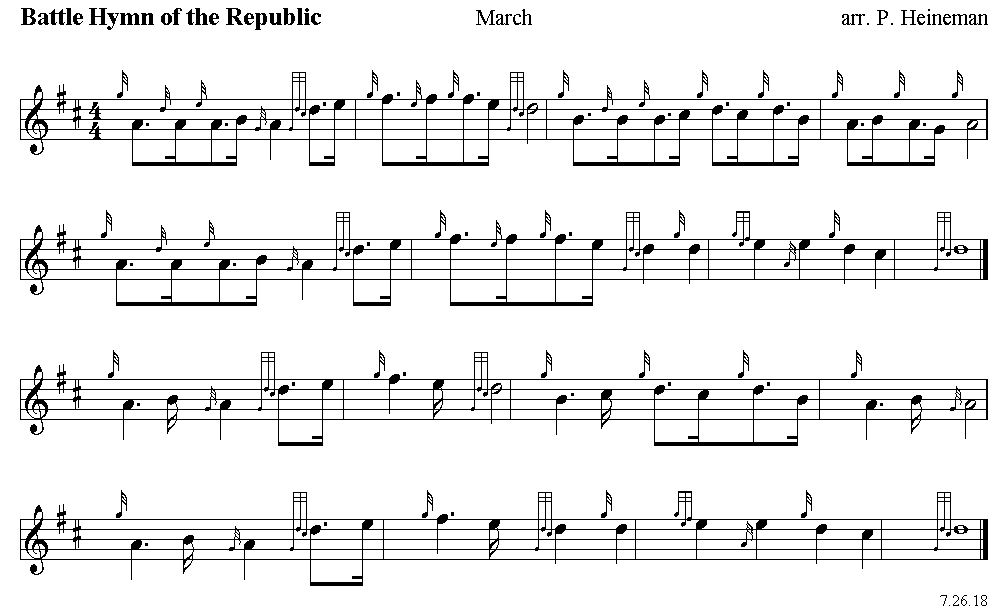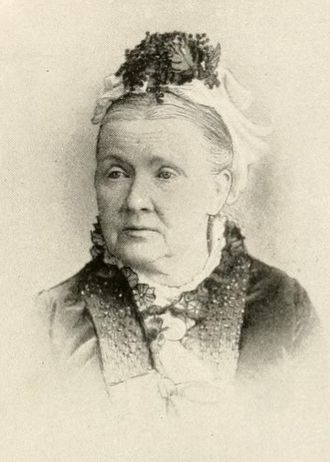|
Mine Eyes Have Seen the Glory
The "Battle
Hymn of the Republic," also known as "Mine Eyes Have Seen
the Glory," outside of the United States, is a lyric by the
American writer Julia Ward Howe (above) using the music from the
song "John Brown's Body." Howe's more famous lyrics were written
in November 1861, and first published in The Atlantic Monthly
in February 1862. The song links the judgment of the wicked at
the end of the age (Old Testament, Isaiah 63; New Testament,
Rev. 19) with the American Civil War.
On Nov. 18, 1861,
Julia Ward Howe, a prominent Boston poet, attended a review of
Union troops outside Washington, D.C. As her carriage made its
way back to the city, inching along roads clogged with marching
soldiers, Howe and her companions began singing some of the
popular songs of the day, among them “John Brown’s Body,” an
earthy Union marching tune. Together, the troops and the
civilian spectators belted out the song’s rousing chorus:
“Glory, glory hallelujah, his soul is marching on!” One of
Howe’s traveling companions suggested that she write some more
elevated lyrics for the tune. She replied that she had often
thought of doing so, but that the words had not yet come to her.
That night, as
she slept at the Willard Hotel, the city’s most distinguished
accommodation, the words finally came. As Howe later recalled,
“I awoke in the gray of the morning twilight; and as I lay
waiting for the dawn, the long lines of the desired poem began
to twine themselves in my mind. Having thought out all the
stanzas, I said to myself, ‘I must get up and write these verses
down, lest I fall asleep again and forget them.’ ” She jumped
out of bed, found an old stump of a pen nearby, and scrawled the
verses on the back of a piece of stationery. Falling back to
sleep with a drowsy sense of satisfaction, she thought to
herself, “I like this better than most things that I have
written.”
When she awoke in
the morning, she could not recall the words that had come to her
just hours before. But there, on a sheet of paper next to her
bed, she found six stanzas waiting in a neat, if uneven, hand.
“Mine eyes have seen the glory of the coming of the Lord,” the
poem began, and as it unspooled on the page, it continued to
clothe the Union military campaign with biblical, and
specifically apocalyptic, imagery and import. In perhaps its
most famous lines, it compared the sacrifices of Northern
soldiers on the battlefield, borne for the sake of preserving
the Union and abolishing slavery, to the crucifixion of
Christ: “As He died to make men holy, let us die to make men
free.” With only minimal changes—most notably, the jettisoning
of an awkward final stanza—the poem appeared much as it would
when published in the Atlantic Monthly two-and-a-half
months later as the “Battle Hymn of the Republic.”
 |
The “Battle Hymn” soon became the
leading anthem of the Union cause and would emerge as one of the
most enduring works of art of the Civil War years. Meanwhile,
the tale of the poem’s composition—one of the great creation
stories in American letters—became nearly as famous as the poem
itself; it became, in a sense, an inextricable part of the poem.
The millennial meanings attached to the hymn, with its portrayal
of Union forces—God’s “terrible swift sword”—as apocalyptic
agents, and the account of the hymn’s origins fed off each
other. Together, they encouraged a sense of providential
national identity deeply seductive to American audiences—then
and now.
Julia Ward Howe portrayed herself as a
millennial witness, faithfully transcribing what her eyes had
seen, but others depicted her as a medium, channeling the
North’s righteous resolve. As Julia Ward Howe’s daughter
declared in an essay on the song, “The soul of the vast army of
the American people struggling for utterance in the greatest
crisis of its existence” found expression in the “Battle Hymn.”
It was “the work not of an individual, but of a nation.” Echoing
that account, one mid-20th-century historian dubbed
the hymn “the song that wrote itself.” |

Lyrics by
Julia Ward Howe
|
|
Mine
eyes have seen the glory of the coming of the Lord;
He is trampling out the vintage where the grapes of
wrath are stored;
He hath loosed the fateful lightning of His terrible
swift sword:
His truth is marching on.
(Chorus)
Glory, Glory, hallelujah!
Glory, glory, hallelujah!
Glory, glory, hallelujah!
His truth is marching on.
I have seen Him in the watch-fires of a hundred circling
camps,
They have builded Him an altar in the evening dews and
damps;
I can read His righteous sentence by the dim and flaring
lamps:
His day is marching on.
(Chorus)
Glory, glory, hallelujah!
Glory, glory, hallelujah!
Glory, glory, hallelujah!
His day is marching on.
I have read a fiery gospel writ in burnished rows of
steel:
"As ye deal with my contemners, so with you my grace
shall deal";
Let the Hero, born of woman, crush the serpent with his
heel,
Since God is marching on.
(Chorus)
Glory, glory, hallelujah!
Glory, glory, hallelujah!
Glory, glory, hallelujah!
Since God is marching on. |
He
has sounded forth the trumpet that shall never call
retreat;
He is sifting out the hearts of men before His
judgment-seat;
Oh, be swift, my soul, to answer Him! Be jubilant, my
feet!
Our God is marching on.
(Chorus)
Glory, glory, hallelujah!
Glory, glory, hallelujah!
Glory, glory, hallelujah!
Our God is marching on.
In the beauty of the lilies
Christ was born across the sea,
With a glory in His bosom that transfigures you and me.
As He died to make men holy, let us die* to make men
free,
While God is marching on.
(Chorus)
Glory, glory, hallelujah!
Glory, glory, hallelujah!
Glory, glory, hallelujah!
While God is marching on.
*
Many modern recordings of the Battle Hymn of the
Republic use the lyric "As He died to make men holy, let
us live to make men free" as opposed to the lyric
originally written by Julia Ward Howe: "let us die to
make men free". |
|
